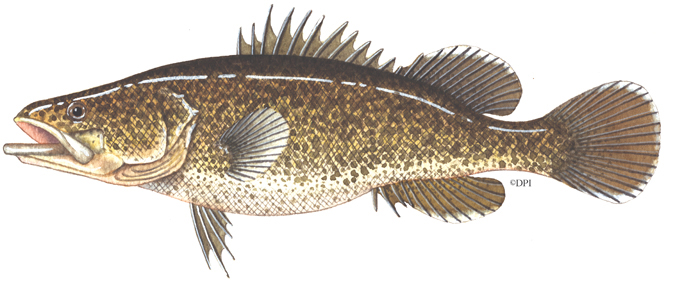Murray cod

| Common Name: | Murray cod |
| Other Name/s: | Cod |
| Family: | Percichthyidae |
| Scientific Name: | Maccullochella peeli (Mitchell, 1838) |
| Origin: | Native |
Conservation Status
State: Classified as "threatened" under the Flora and Fauna Guarantee Act 1988.
Federal: Classified as "vulnerable" under the Environment Protection and Biodiversity Conservation Act 1999.
Description
Broad head with a depressed profile. Rounded snout, with jaws either equal or the lower jaw longer. A large mouth reaching behind the small eye. Rounded tail.
Back colour varies from brown or olive-green to yellow-green with brown to pale green mottling on the upper body, sides and fin bases.
Belly is white and the edges of the dorsal and tail fins may also be white. There is much variation in body shape and colour patterns.
Distribution
Occurs naturally and is widespread throughout the Murray-Darling system, becoming scarcer towards the head-waters. Distribution and abundance had declined through until the 1980's, however there is evidence that populations are becoming re-established in many areas. Has been successfully introduced into a number of waters including the Yarra River.
There are few localities in Victoria where Murray Cod can be considered abundant.
Habitat
Occurs most frequently in sluggish, turbid waters, usually in deep holes, where logs and stumps afford cover and provide spawning sites. Will live and breed in lakes if water conditions and habitat are suitable. Occurs naturally in upper reaches of the Murray-Darling system where the water is relatively clear and there is little fallen timber.
Brief Biology
Murray cod can attain 1.8 metres in length and 113.5 kg, and commonly reaches 55-65 cm and weights of 2-5 kg. Usually sexually mature at 4 years of age, growth is rapid in the first 4-5 years, some individual fish reaching 64 cm in the fifth year.
Spawning occurs in the spring and summer months in water temperatures between 16 and 21°C. Females can lay up to 40,000 eggs which are deposited in hollow logs or shallow water. Eggs hatch 6 to 13 days later, with juvenile fish feeding freely about 3-4 weeks later.
Carnivorous, taking a wide variety of food from molluscs and crustaceans to many species of fish, and occasionally water birds such as ducks.
Other Notes
Largest of Australia's native freshwater fishes. A recreational species, its distribution and abundance has undergone a reduction through construction of dams, changes to river flows and temperatures and increased siltation of streams.
Flesh of smaller specimens has an excellent flavour and it keeps well; larger specimens tend to be coarse and oily.
Now produced in hatcheries, which permits enhancement of existing populations or restoration of the species to waters considered suitable for survival and growth of released fish.
The Department stocks a number of waters each year with juvenile Murray cod produced at its Snobs Creek Hatchery near Eildon or purchased from commercial fish farms.
Murray cod was originally believed to be very territorial with a movement range of less than 10 km, which suggested that local effects such as overfishing, pollution or destruction of spawning areas could seriously reduce or eliminate local populations.
Studies in the lower Ovens River tracking Murray cod carrying miniature radio transmitters has revealed a much greater range during flood/spawning times, with distances up to 90 km before returning to almost the original location.
Regulations
Recreational Fishing Licence requirements, and regulations affecting the taking of Murray cod in Victoria, are provided in the Victorian Recreational Fishing Guide, available free from RFL sales agents and DEDJTR Offices and Information Centres.
Further Reading
- A Guide to the Freshwater Fish of Victoria, Phillip Cadwallader & Gary Backhouse, Department of Conservation and Environment.
- Australian Freshwater Fishes, John R. Merrick & Gunther E. Schmida.
- Biological Information for Management of Native Freshwater Fish in Victoria, J D Koehn, W G O'Connor.

